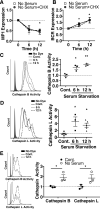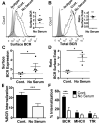Macronutrient deprivation modulates antigen trafficking and immune recognition through HSC70 accessibility
- PMID: 25589076
- PMCID: PMC4324325
- DOI: 10.4049/jimmunol.1402472
Macronutrient deprivation modulates antigen trafficking and immune recognition through HSC70 accessibility
Abstract
B lymphocytes exploit macroautophagy to capture cytoplasmic and nuclear proteins within autophagosomes. Fusion of autophagosomes with lysosomes and endosomes facilitates content proteolysis, with the resulting peptides selectively binding MHC class II (MHC II) molecules, which are displayed for recognition by T lymphocytes. Nutrient deprivation or stress amplified this pathway, favoring increased MHC II presentation of cytoplasmic Ags targeted to autophagosomes. By contrast, this stress diminished MHC II presentation of membrane Ags including the BCR and cytoplasmic proteins that use the chaperone-mediated autophagy pathway. Whereas intracellular protease activity increased with nutrient stress, endocytic trafficking and proteolytic turnover of the BCR was impaired. Addition of macronutrients such as high molecular mass proteins restored endocytosis and Ag presentation, evidence of tightly regulated membrane trafficking dependent on macronutrient status. Altering cellular levels of the cytosolic chaperone HSC70 was sufficient to overcome the inhibitory effects of nutritional stress on BCR trafficking and Ag presentation. Together, these results reveal a key role for macronutrient sensing in regulating immune recognition and the importance of HSC70 in modulating membrane trafficking pathways during cellular stress.
Copyright © 2015 by The American Association of Immunologists, Inc.
Figures







Similar articles
-
A central role for HSC70 in regulating antigen trafficking and MHC class II presentation.Mol Immunol. 2015 Dec;68(2 Pt A):85-8. doi: 10.1016/j.molimm.2015.04.007. Epub 2015 May 4. Mol Immunol. 2015. PMID: 25953005 Free PMC article. Review.
-
LAMP-2C Inhibits MHC Class II Presentation of Cytoplasmic Antigens by Disrupting Chaperone-Mediated Autophagy.J Immunol. 2016 Mar 15;196(6):2457-65. doi: 10.4049/jimmunol.1501476. Epub 2016 Feb 8. J Immunol. 2016. PMID: 26856698 Free PMC article.
-
The actin-based motor protein myosin II regulates MHC class II trafficking and BCR-driven antigen presentation.J Cell Biol. 2007 Mar 26;176(7):1007-19. doi: 10.1083/jcb.200611147. J Cell Biol. 2007. PMID: 17389233 Free PMC article.
-
Antigen-loading compartments for major histocompatibility complex class II molecules continuously receive input from autophagosomes.Immunity. 2007 Jan;26(1):79-92. doi: 10.1016/j.immuni.2006.10.018. Epub 2006 Dec 21. Immunity. 2007. PMID: 17182262 Free PMC article.
-
Autophagy in MHC class II antigen processing.Curr Opin Immunol. 2007 Feb;19(1):87-92. doi: 10.1016/j.coi.2006.11.009. Epub 2006 Nov 28. Curr Opin Immunol. 2007. PMID: 17129719 Review.
Cited by
-
A central role for HSC70 in regulating antigen trafficking and MHC class II presentation.Mol Immunol. 2015 Dec;68(2 Pt A):85-8. doi: 10.1016/j.molimm.2015.04.007. Epub 2015 May 4. Mol Immunol. 2015. PMID: 25953005 Free PMC article. Review.
-
HSPA8 Is a New Biomarker of Triple Negative Breast Cancer Related to Prognosis and Immune Infiltration.Dis Markers. 2022 Nov 21;2022:8446857. doi: 10.1155/2022/8446857. eCollection 2022. Dis Markers. 2022. PMID: 36452344 Free PMC article.
-
Heat shock cognate protein 70 promotes the differentiation of C2C12 myoblast and targets Yin Yang 1.Ann Transl Med. 2019 Oct;7(20):551. doi: 10.21037/atm.2019.09.88. Ann Transl Med. 2019. PMID: 31807532 Free PMC article.
-
LAMP-2C Inhibits MHC Class II Presentation of Cytoplasmic Antigens by Disrupting Chaperone-Mediated Autophagy.J Immunol. 2016 Mar 15;196(6):2457-65. doi: 10.4049/jimmunol.1501476. Epub 2016 Feb 8. J Immunol. 2016. PMID: 26856698 Free PMC article.
-
Induction of anti-EGFR immune response with mimotopes identified from a phage display peptide library by panitumumab.Oncotarget. 2016 Nov 15;7(46):75293-75306. doi: 10.18632/oncotarget.12167. Oncotarget. 2016. PMID: 27659529 Free PMC article.
References
-
- Hansen MA, Fernandes G, Good RA. Nutrition and immunity: the influence of diet on autoimmunity and the role of zinc in the immune response. Annual review of nutrition. 1982;2:151–177. - PubMed
-
- Scrimshaw NS, Taylor CE, Gordon JE. Interactions of nutrition and infection. Monograph series. World Health Organization. 1968;57:3–329. - PubMed
-
- Taiwo OO, Thomas KD. Plasma biochemical parameters in Nigerian children with protein energy malnutrition. East African medical journal. 1992 Aug;69:428–432. - PubMed
-
- Cripps AW, Otczyk DC, Barker J, Lehmann D, Alpers MP. The relationship between undernutrition and humoral immune status in children with pneumonia in Papua New Guinea. Papua and New Guinea medical journal. 2008 Sep-Dec;51:120–130. - PubMed
Publication types
MeSH terms
Substances
Grants and funding
LinkOut - more resources
Full Text Sources
Other Literature Sources
Research Materials
Miscellaneous

